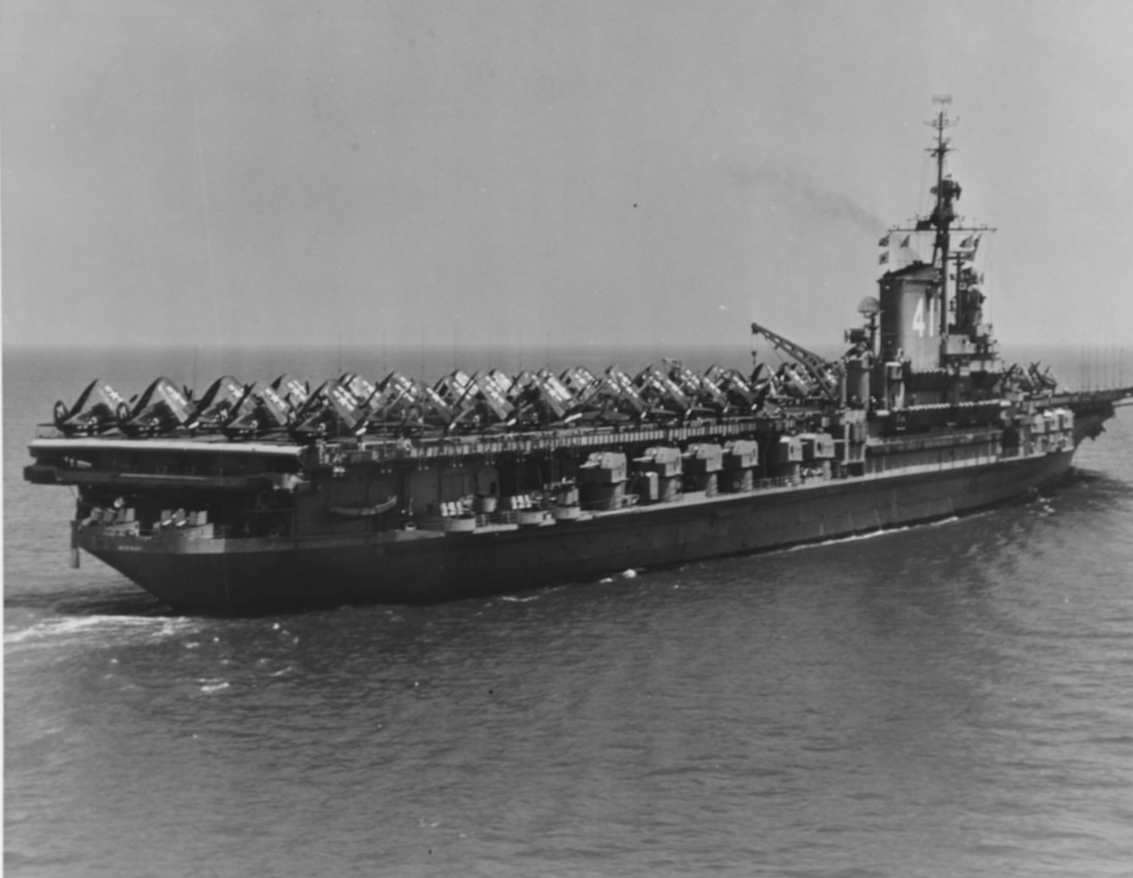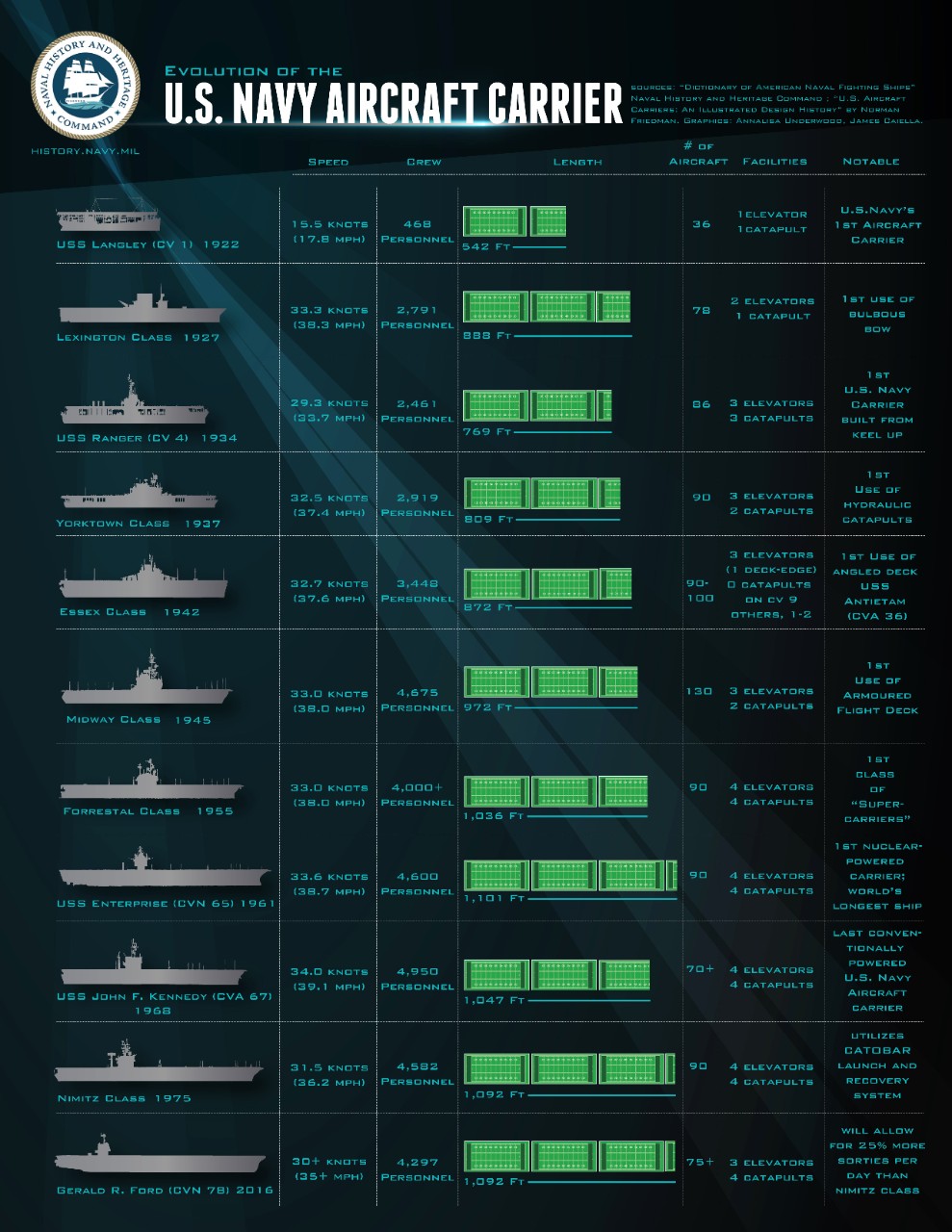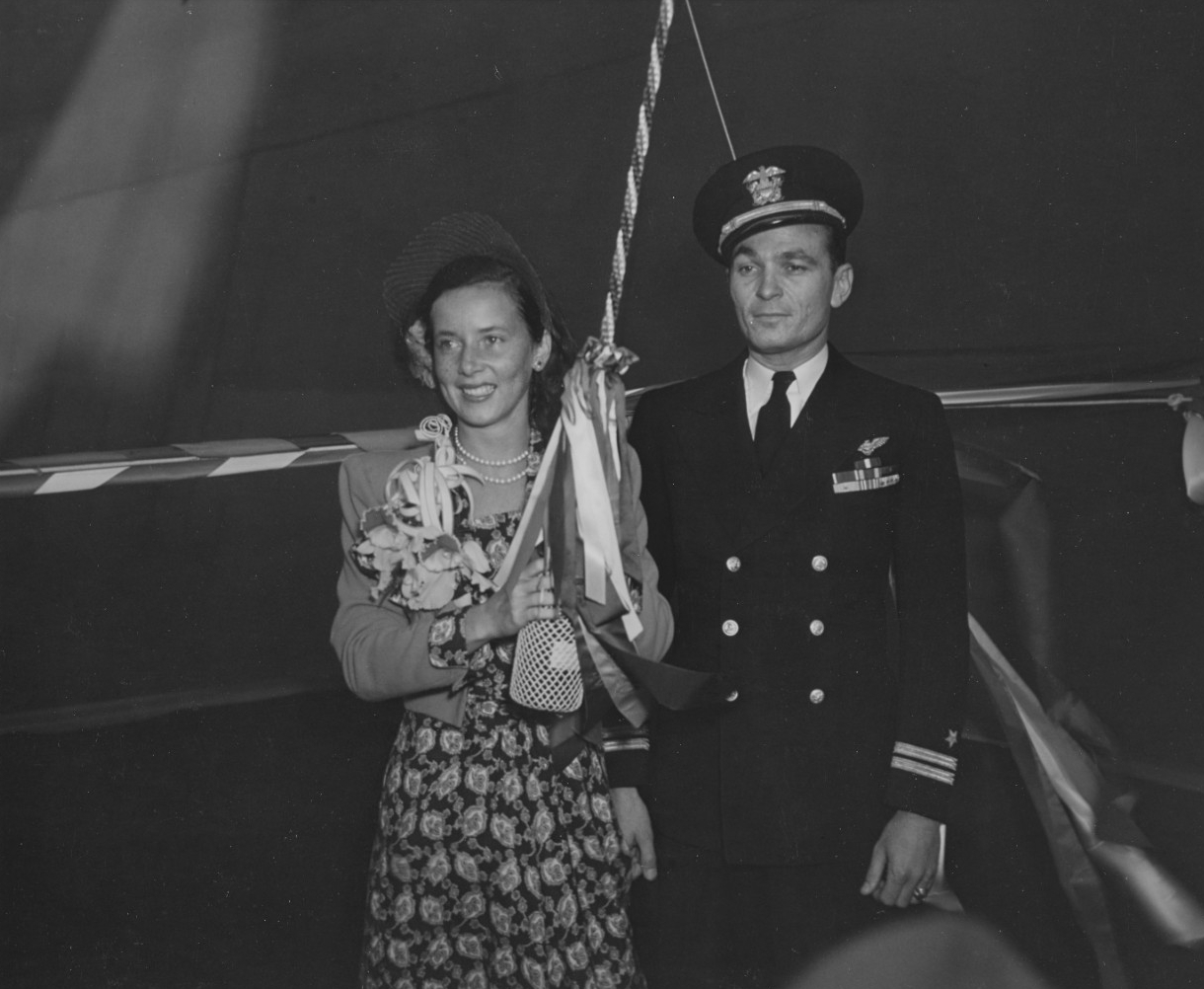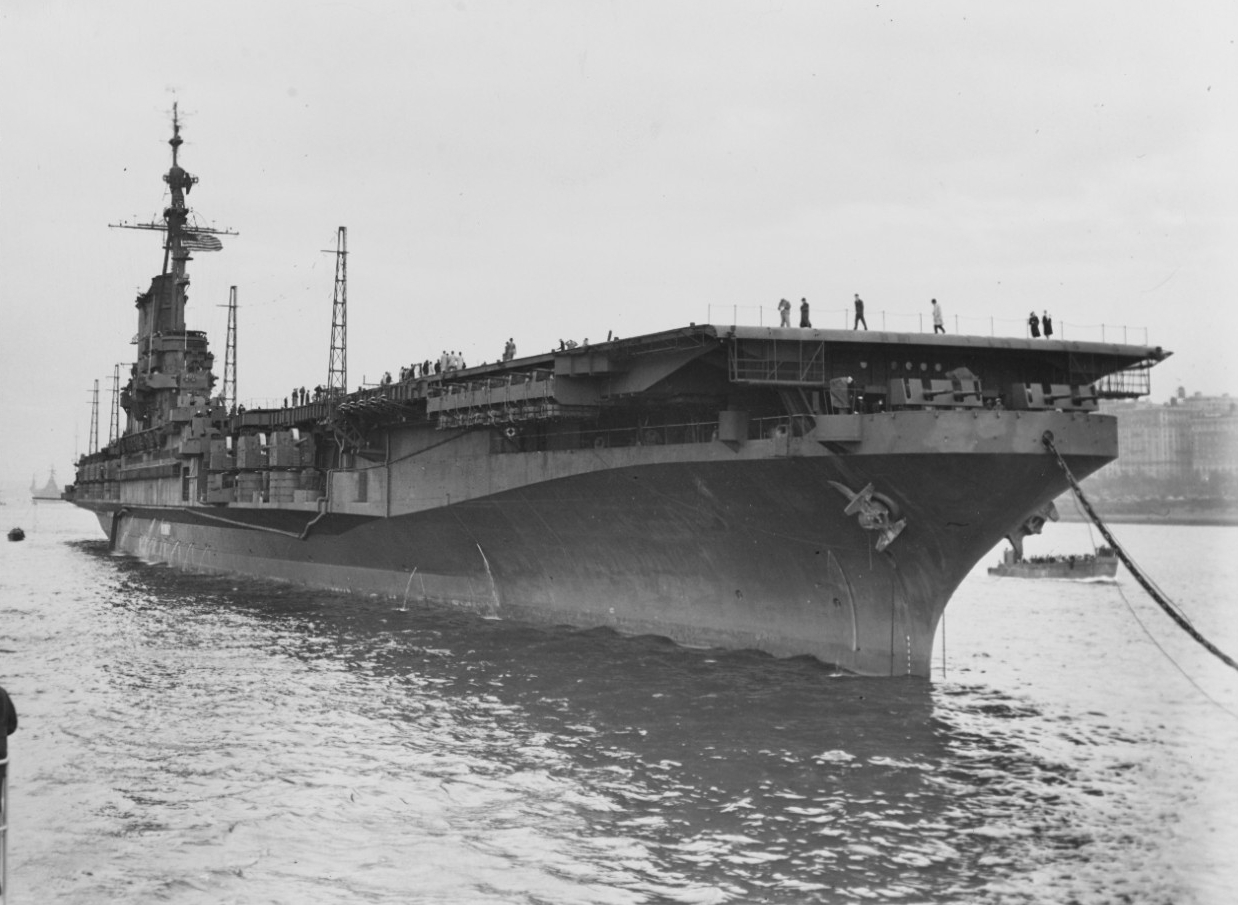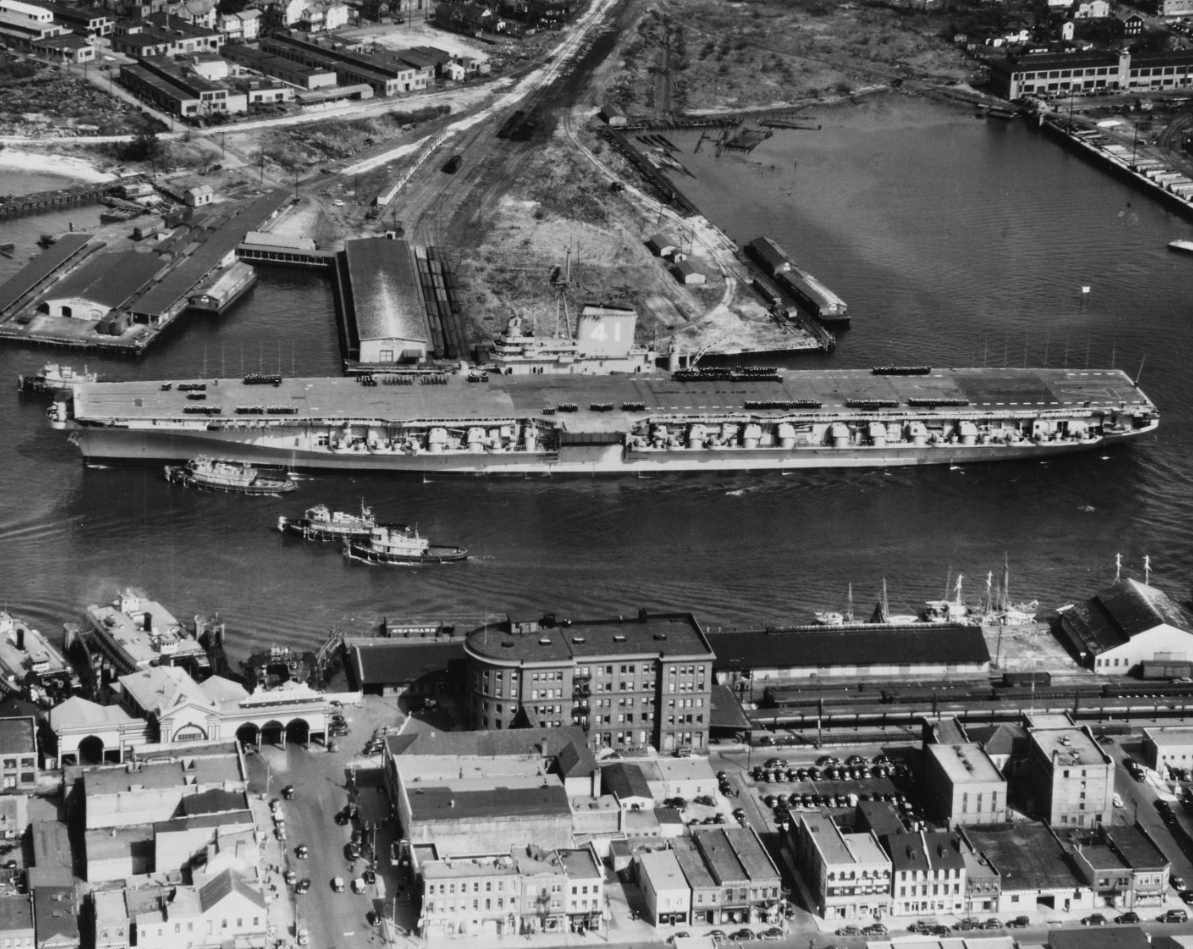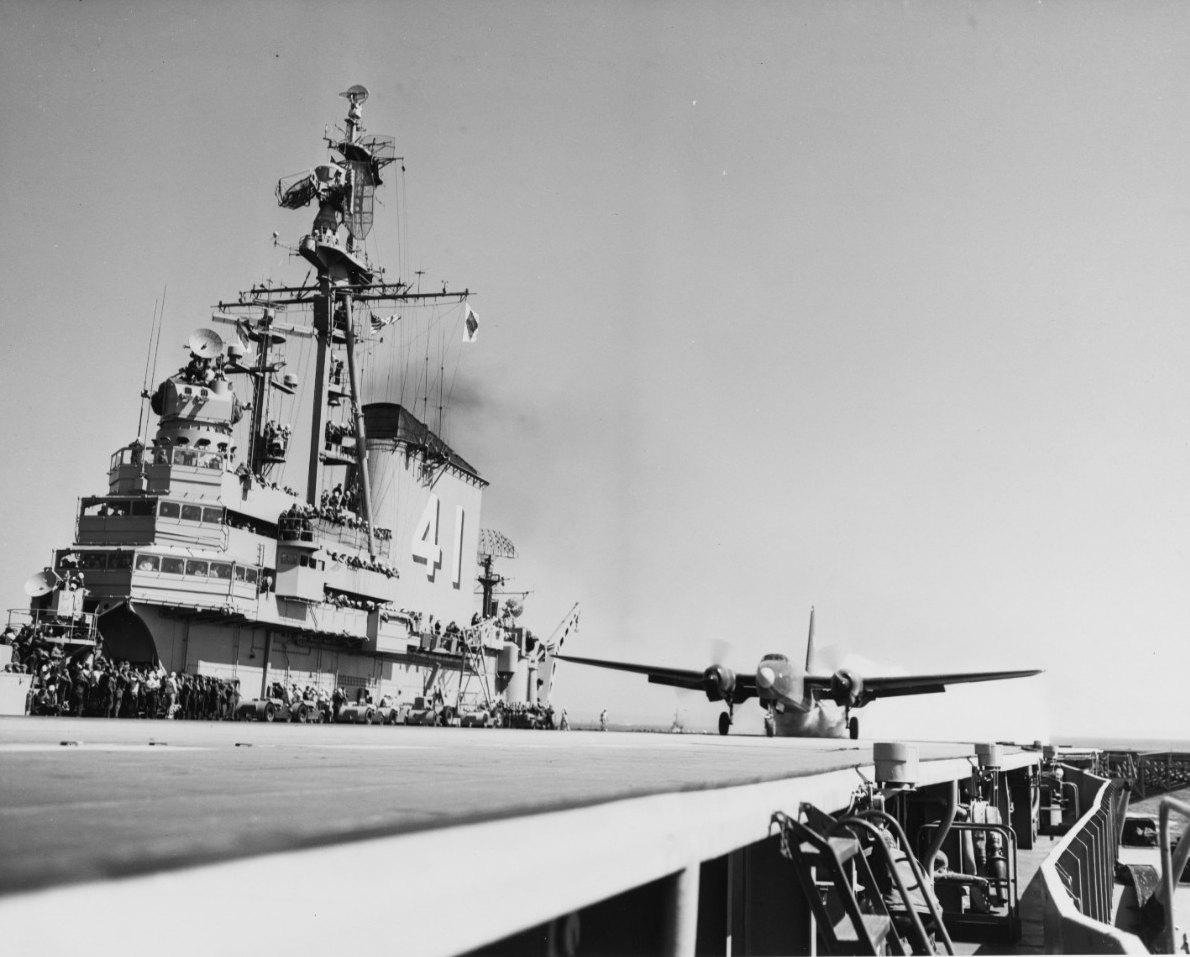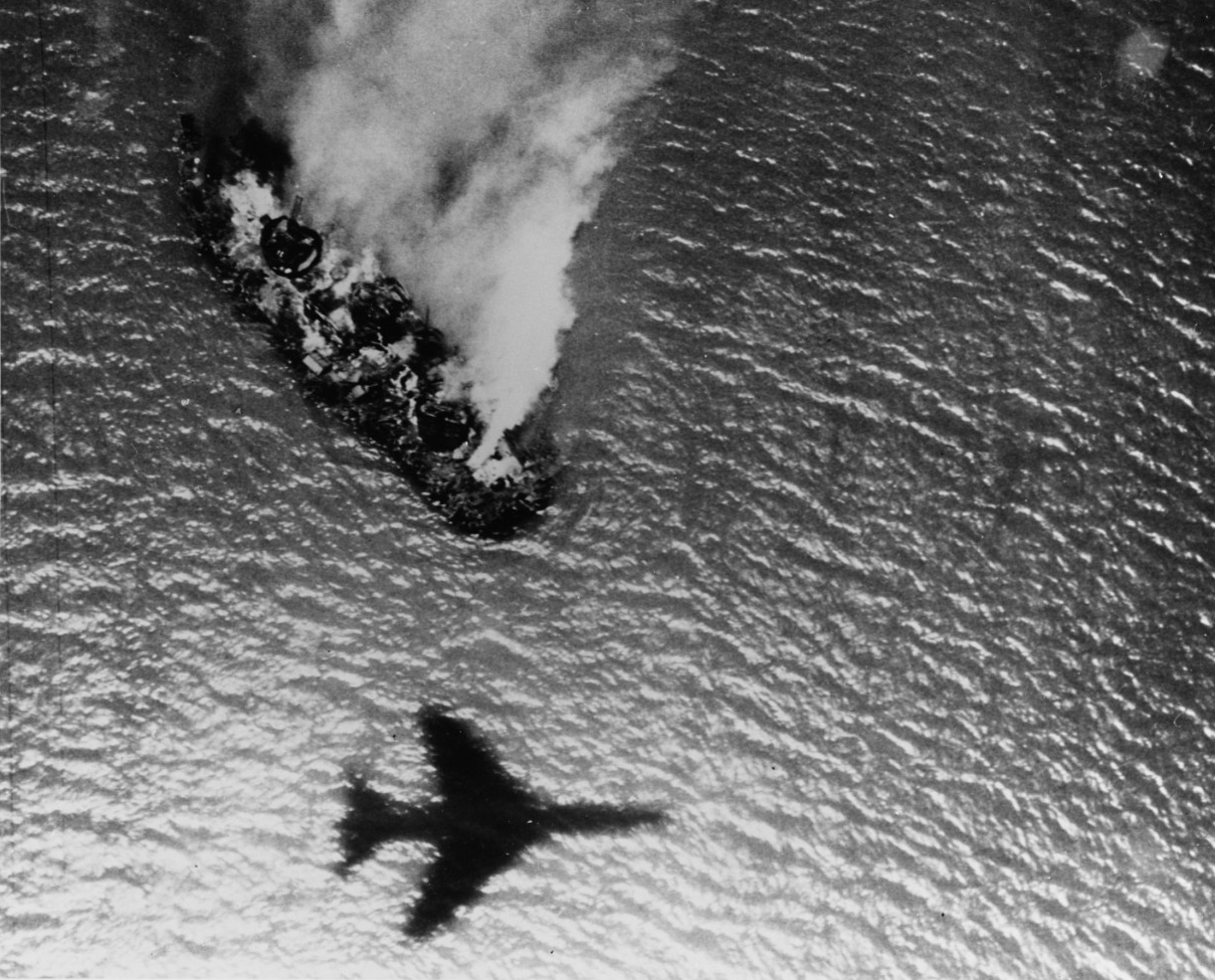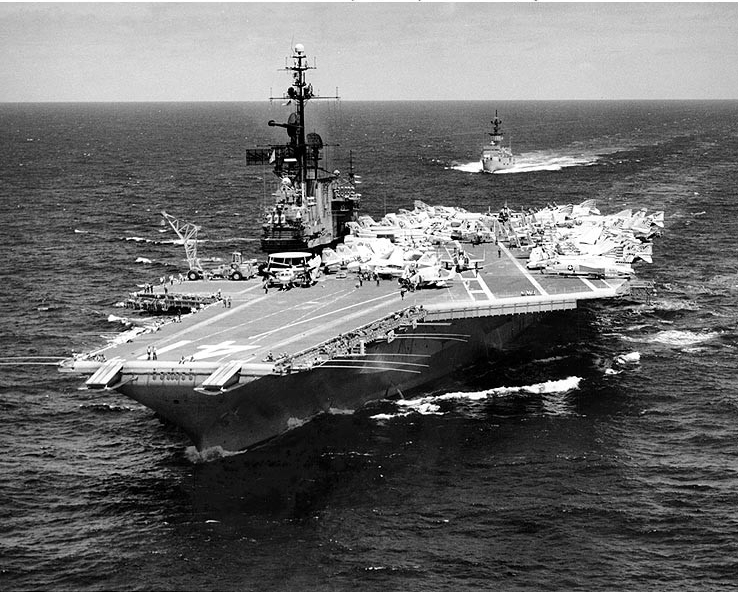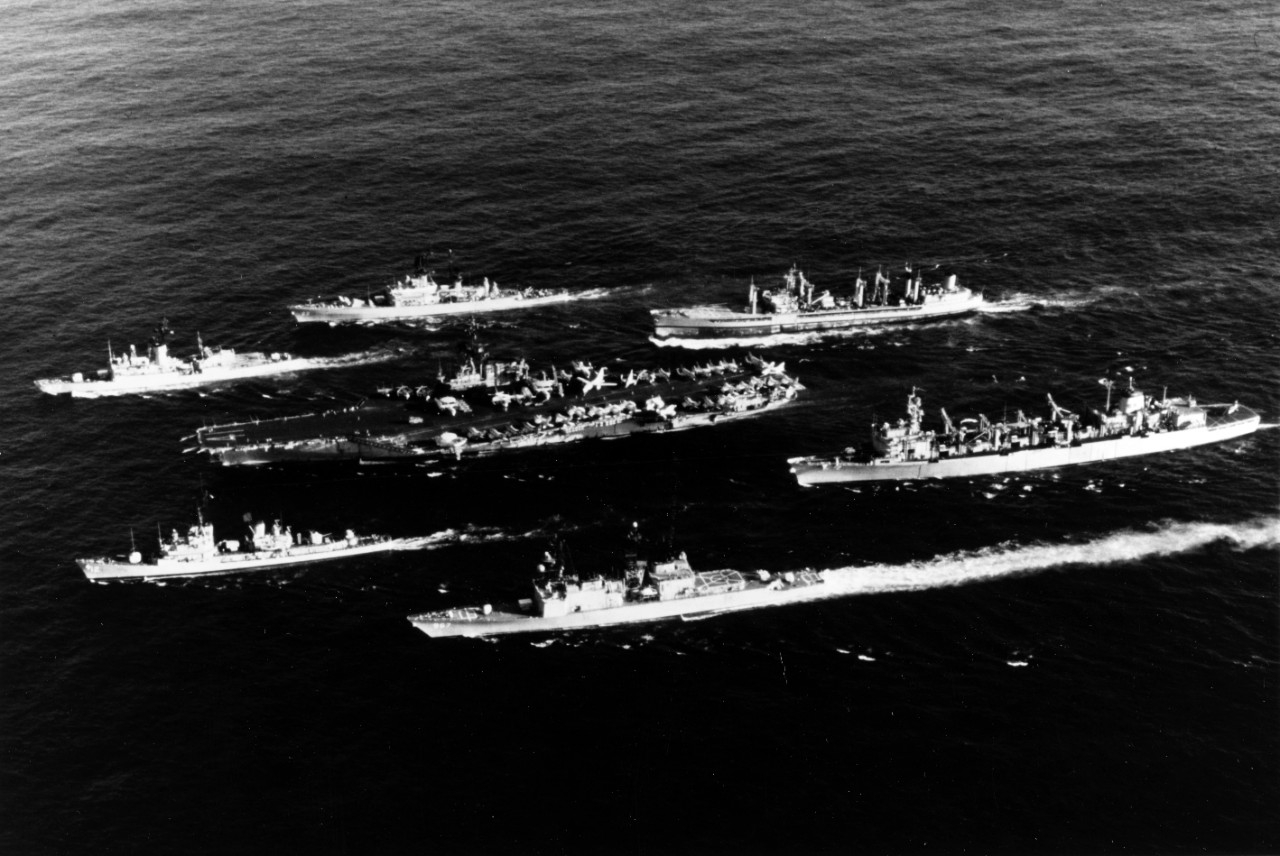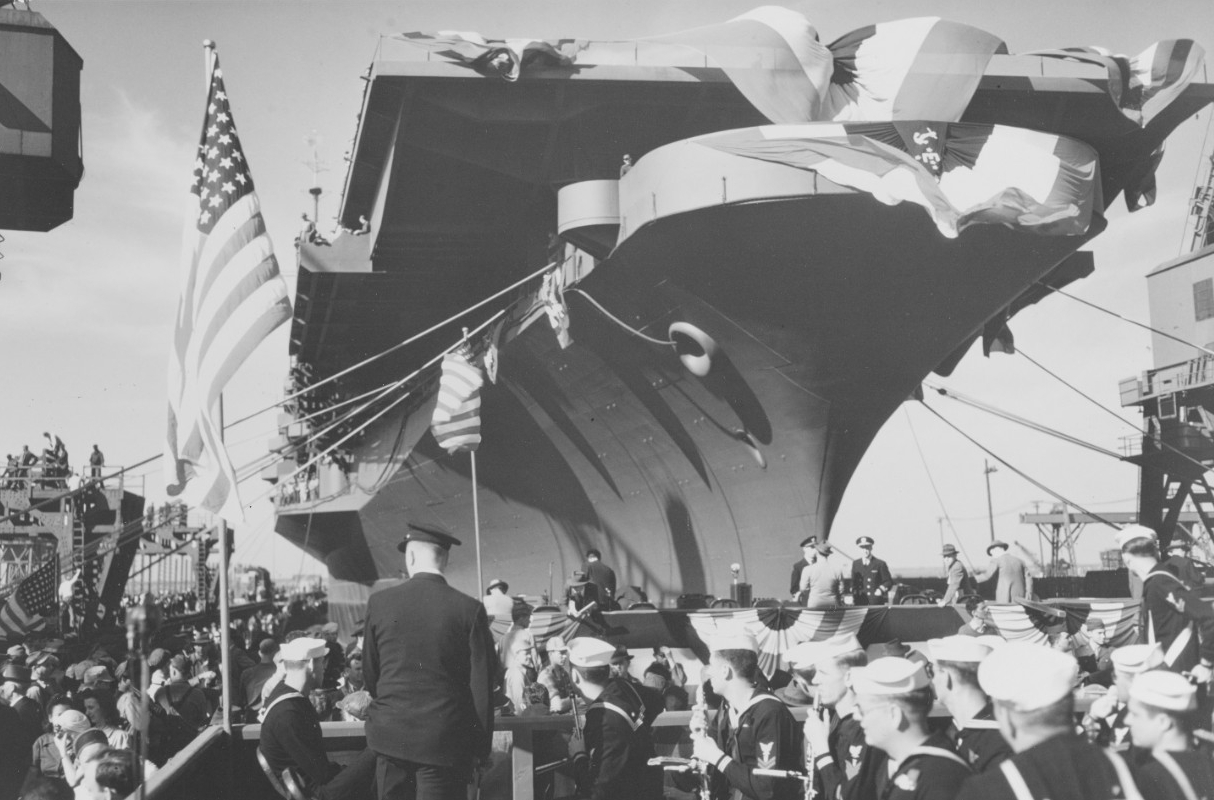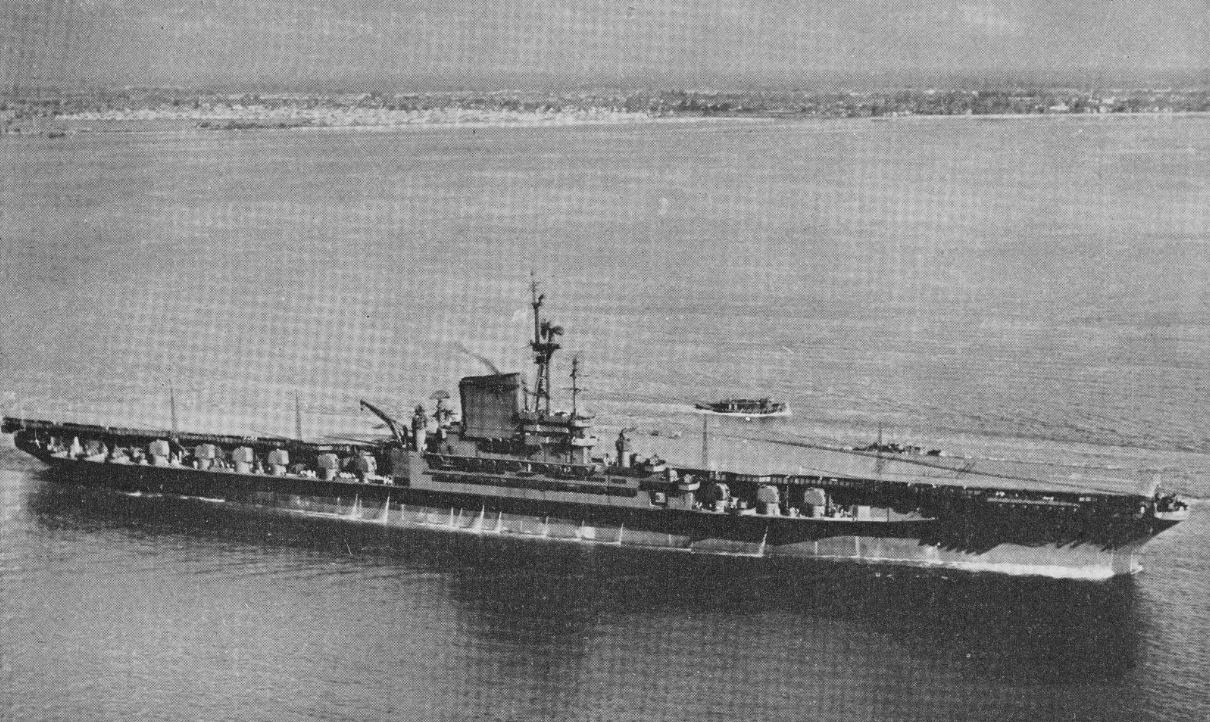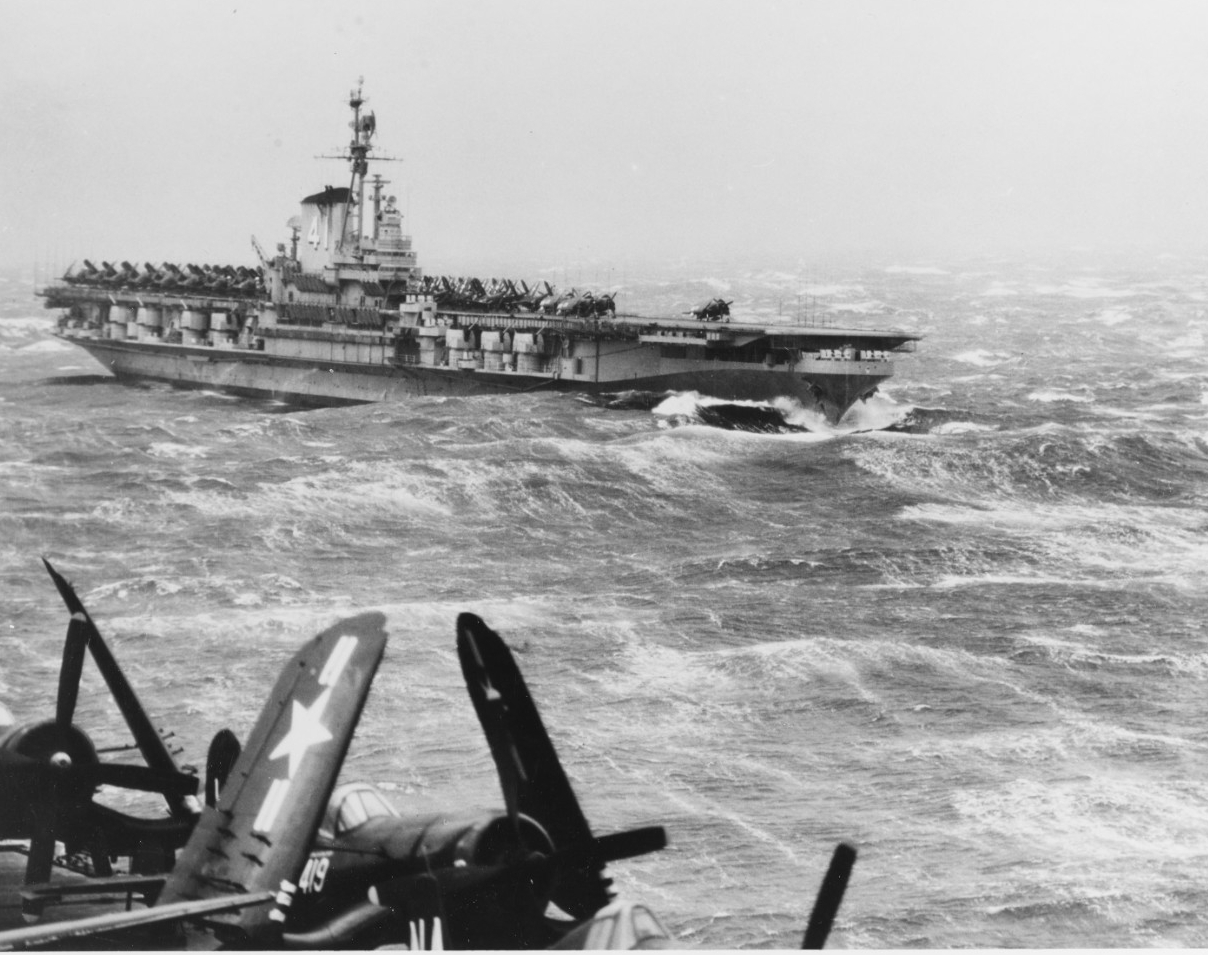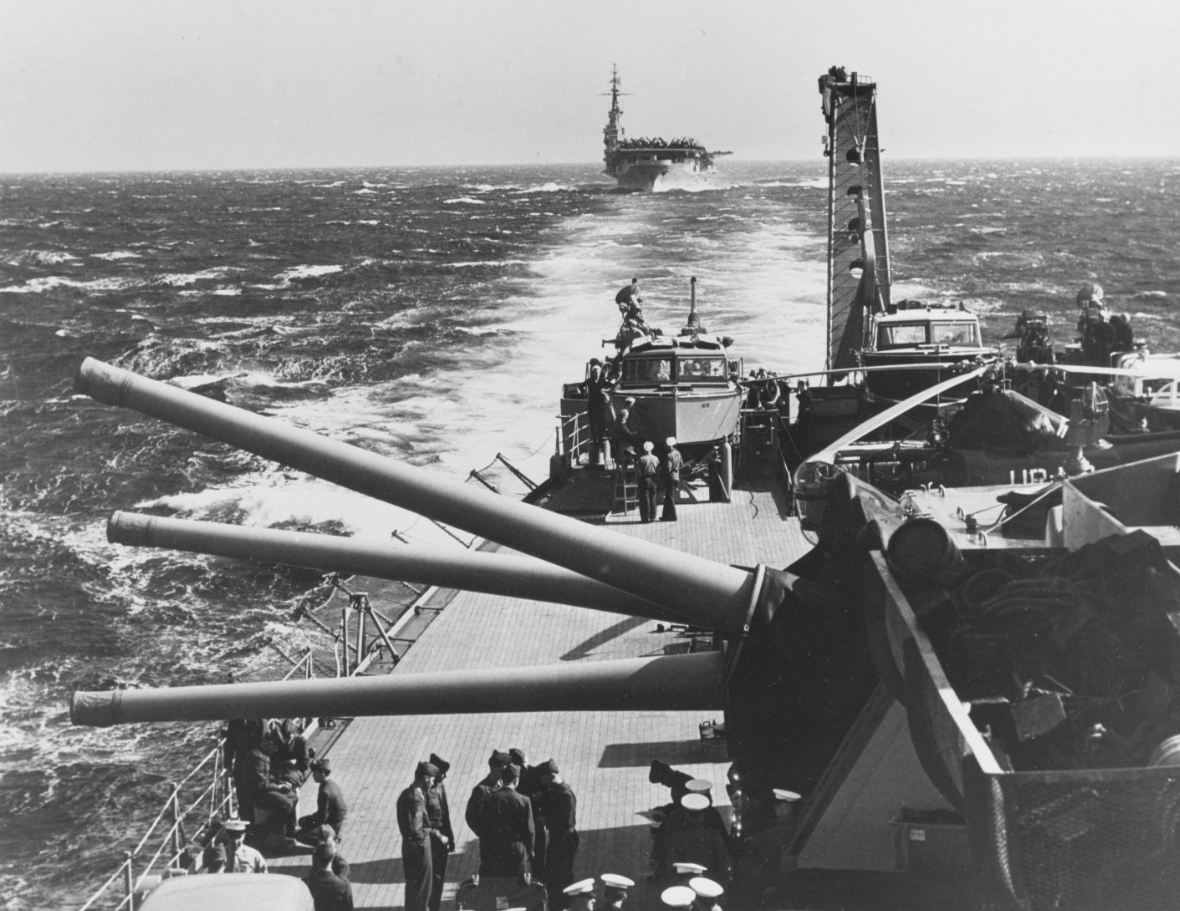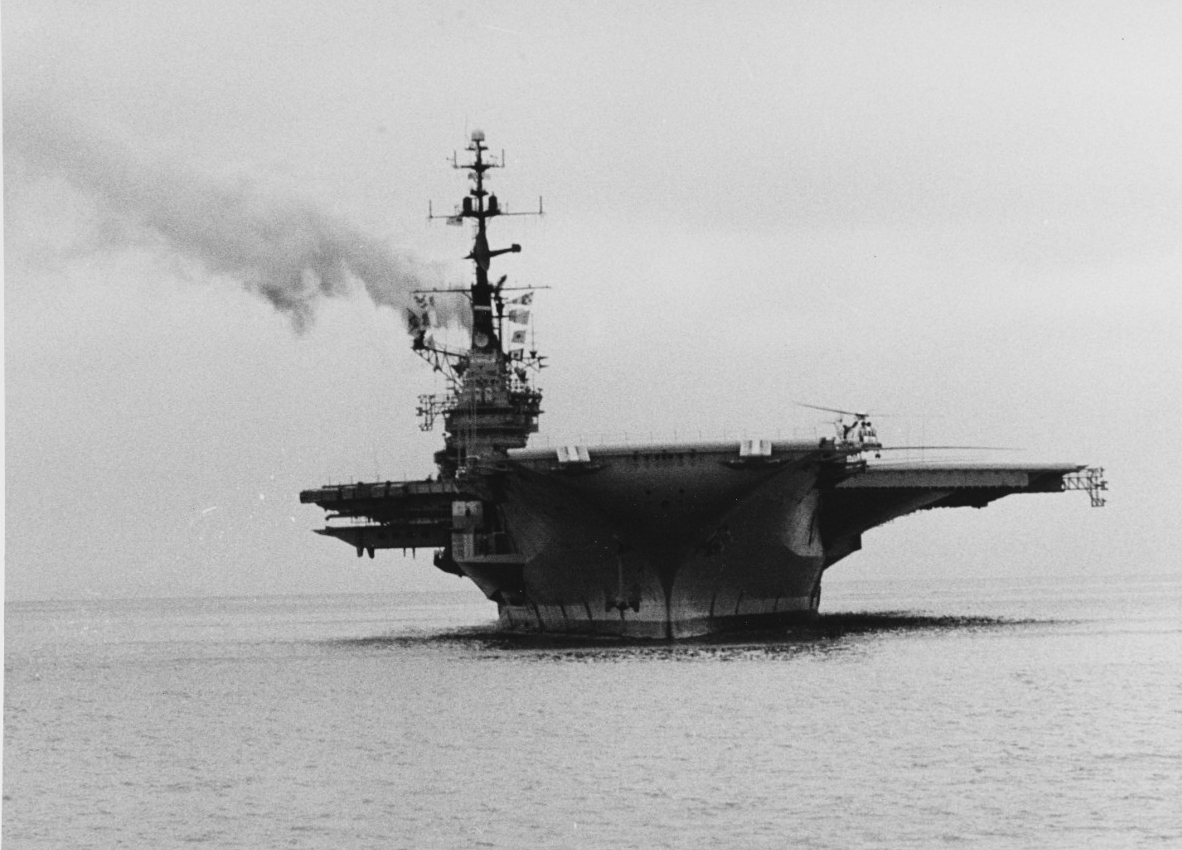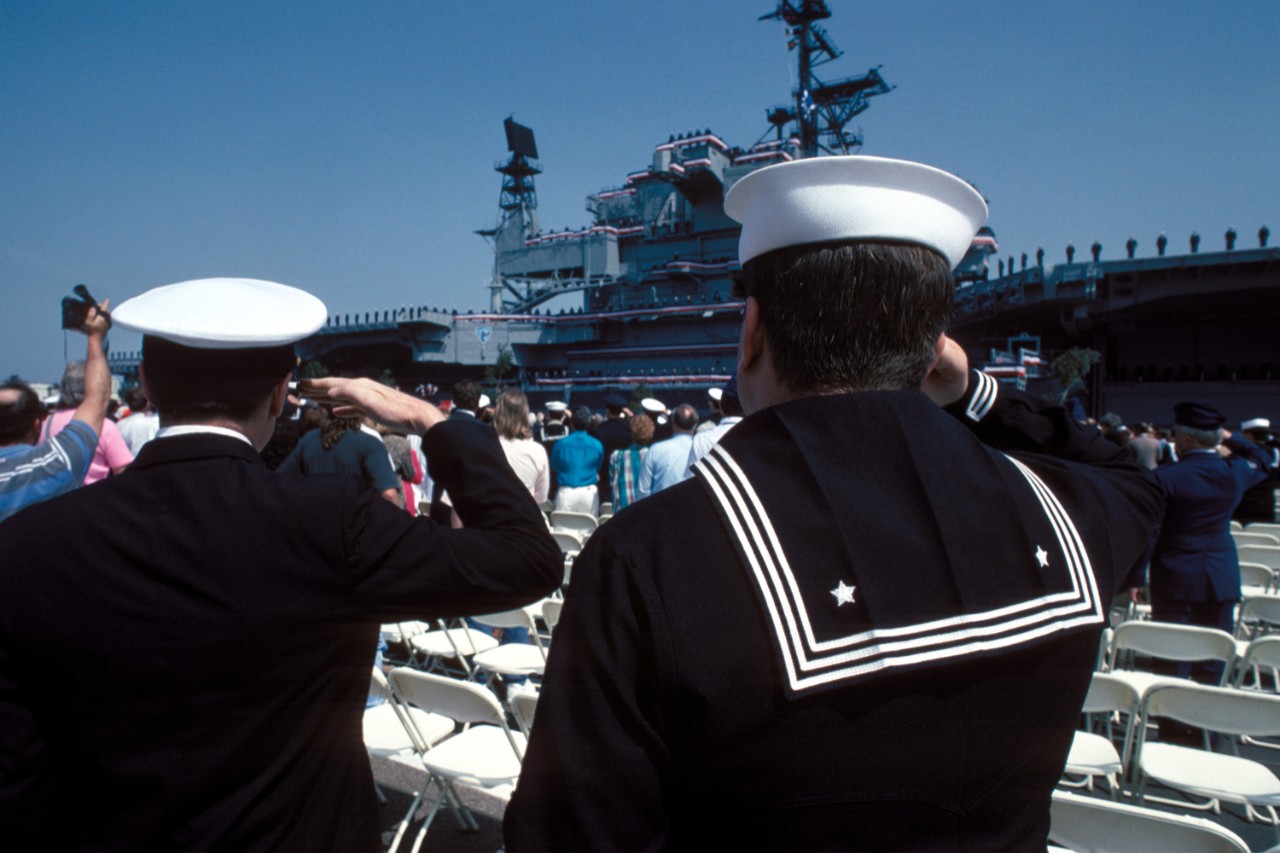USS Midway (CVB-41)
Named for the U.S. Navy’s landmark victory at the Battle of Midway, USS Midway (CVB-41) was commissioned 10 September 1945 with Captain Joseph F. Bolger in command. She began her service with the Navy just eight days after the instrument of surrender was signed by representatives of the Allied and Japanese governments onboard USS Missouri (BB-63) in Tokyo Bay. Midway, first in her class, was at the time the largest ship in the world, and the first U.S. aircraft carrier that was too big to transit the Panama Canal. The “supercarrier” was equipped with an armored flight deck, weighed in at 45,000 tons at commissioning, housed more than 100 aircraft, and was complimented by a crew of more than 4,000 Sailors and Marines.
After a shakedown cruise in the Caribbean, Midway joined the Atlantic Fleet with Norfolk, Virginia, as her homeport. From 20 February 1946, she served as flagship for Carrier Division 1. In March, Midway participated in Operation Frostbite, where she tested equipment and techniques for cold weather operations in the North Atlantic. In September 1947, during Operation Sandy, she test‑fired a captured German V‑2 rocket from her flight deck—the first such launch from a moving platform. The following month, Midway was underway for the first of her annual deployments with Sixth Fleet in the Mediterranean. Between deployments, she received alterations to accommodate heavier aircraft as they were developed.
In June 1951, Midway was conducting suitability tests off the Virginia Capes. On 23 June, Commander George Duncan, who was the recipient of the Navy Cross and the Silver Star during World War II, attempted to land his F9F Panther on Midway when a downdraft just aft of the stern caused him to crash. The aircraft’s fuselage broke away and rolled down the deck. He survived the dramatic crash, but was badly burned. He returned to flying six months later. Footage of the crash has been used in several films, including Men of the Fighting Lady, Midway, and The Hunt for Red October.
In 1952, Midway participated in North Sea maneuvers with NATO forces, and on 1 October, she was redesignated as an attack aircraft carrier (CVA-41). On 27 December 1954, Midway departed Norfolk for a world cruise, steaming via the Cape of Good Hope for Taiwan, where she joined Seventh Fleet for operations in the western Pacific. During the operations, Midway aviators flew cover for the Tachen Islands evacuation during the Quemoy-Matsu crisis. She continued to operate in the western Pacific until 28 June 1955 when she made way for Bremerton, Washington, for an overhaul at the Puget Sound Naval Shipyard. While there, she lay out of commission until September 1957 while she was modernized, receiving new innovations such as an enclosed bow and an angled flight deck.
After the renovations, Midway changed homeports to Alameda, California, where she participated in annual deployments with Seventh Fleet, and was on such duty in the South China Sea during the Laotian crisis during the spring of 1961. During her 1962 deployment, Midway’s aircraft tested the air defense systems of Japan, Korea, Okinawa, the Philippines, and Taiwan. When she again steamed for the Far East on 6 March 1965, her aircraft were prepared for combat operations, and from mid‑April flew strikes against military and logistics installations in North and South Vietnam. Illustrative of the major contribution Midway made to the Vietnam War was a notable “first” for aviators of her Attack Carrier Wing 2, who in June downed the first three MIGs credited to U.S. Forces in Southeast Asia. She returned to Alameda later that year and entered the San Francisco Bay Naval Shipyard on 11 February 1966 for extensive modernization.
Midway returned to Vietnam, and beginning in May 1971, conducted single carrier operations at Yankee Station that lasted until November when she returned to Alameda. In April 1972, Midway once again returned to Vietnam and participated in Operation Linebacker throughout the summer. Notably during the tour, Midway’s Helicopter Combat Support Squadron 7 rescued 48 downed pilots. She received the Presidential Unit Citation from President Richard Nixon for her “extraordinary heroism and outstanding performance” during the tour. Midway returned to Vietnam in 1975 where she participated in Operation Frequent Wind—the final phase in the evacuation of American civilians and “at-risk” Vietnamese in wake of the fall of Saigon.
After the war, Midway participated in several “show of force” operations to include Operation Paul Bunyan off the Korean coast in 1976, and in the North Arabian Sea during the Iran Hostage Crisis in 1979–80. Throughout the 1980s, Midway continued to operate mostly in the western Pacific. In 1986, Midway underwent refit to alleviate persistent seakeeping issues. Hull blisters were added to improve the ship's stability, but the modifications actually made the ship more unstable in heavy seas. Another refit was ordered to correct the instability problem. During a typhoon while in the Sea of Japan during the Olympic Games in Seoul, Korea, on 8 October 1988, Midway, which was not supposed to be able to sustain more than 24-degrees of roll, survived a 26-degree roll.
On 2 August 1990, the Iraqi army invaded Kuwait. U.S. forces were swiftly deployed to Saudi Arabia as part of Operation Desert Shield to protect that country from further Iraqi aggression. In November, Midway was once again in the North Arabian Sea as part of Battle Force Zulu. On 15 November, Midway participated in Operation Imminent Thunder, an eight-day combined amphibious landing exercise in northeastern Saudi Arabia. Meanwhile, the United Nations set an ultimatum of 15 January 1991 for Iraq to leave Kuwait. After Iraq’s leader, Saddam Hussein, repeatedly refused to withdrawal his troops from Kuwait, Operation Desert Storm commenced. Midway, along with a massive multi-country contingency, launched aircraft to conduct the first carrier strikes of the Gulf War. The bombardment by air assets and the effects of the economic embargo decimated Iraq's military infrastructure and morale, degraded communications and supplies, and devastated weapons arsenals. After the 38-day air campaign, ground troops began sweeping through Kuwait in blitzkrieg fashion. In a mere 100 hours, the Iraqi army was crushed and Kuwait was free. Midway departed the Persian Gulf in March.
In June 1991, Midway participated in Operation Fiery Vigil, the evacuation of military members and their families from Clark Air Base on the island of Luzon after the eruption of Mount Pinatubo. Later that year, Midway steamed to Pearl Harbor, where she was relieved as the forward deployed carrier in Yokosuka, Japan. She then steamed to Seattle for a port visit before ultimately making her final voyage to San Diego. Decommissioned on 11 April 1992, Midway was stricken from the Naval Vessel Register on 17 March 1997. On 29 August 2003, Midway was donated to the San Diego Aircraft Museum, and began operation as a museum ship on 13 January 2004.
*****
Suggested Reading
- Naval Aviation
- Surface Navy
- H-Gram 055-2: Operation Desert Shield, November 1990
- Fair Winds Rear Adm. Thomas Francis “Tom” Brown III
- Carrier Deployments during the Vietnam Conflict
- USS Midway Museum
Interviews with USS Midway (CVB-41) Crewmembers
- Donald E. Miller
- Herbert K. Strough
- Edward T. Born, Sr.
- Dallas H. Jones
- Robert C. Hocking
- Gerald A. Buell
- Arnold Brendel
- Vincent D. Farrell
Video Footage
- Carrier Operations aboard USS Midway (CVB-41)
- F9F Panther crash on USS Midway (CVB-41)
- Air Operations on USS Midway (CVB-41)
- World’s Largest Carrier, USS Midway (CVB-41), Launched at Newport News, Virginia
Infographic
Selected Imagery
Mrs. Bradford D. Ripley, USS Midway’s (CVB-41) sponsor, posed with the christening bottle at launching ceremonies at the Newport News Shipbuilding and Dry Dock Company, Newport News, Virginia, 20 March 1945. Ripley was accompanied by Lieutenant George Gay, the only survivor of the Battle of Midway attack by Torpedo Squadron Eight (VT-8) from USS Hornet (CV-8). National Archives photograph, 80-G-K-3516.
A chief petty officer and an enlisted crewman from the aircraft carrier USS Midway (CV-41) rendered salutes at the decommissioning ceremony for the 47 years old veteran ship, 11 April 1992. The only carrier to come close to such lengthy service was USS Coral Sea (CV-43) with just two less years of service. Midway-class ships were constructed late in World War II as battle carriers with armored flight decks to withstand kamikaze attacks. The war ended just as Midway was first commissioned on 10 September 1945.

